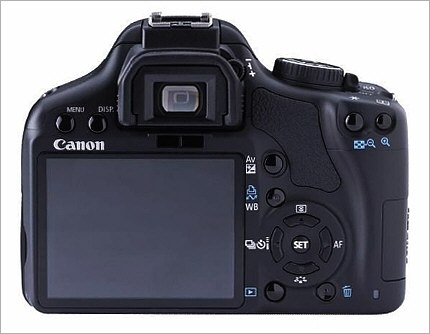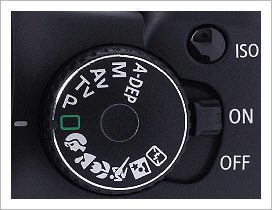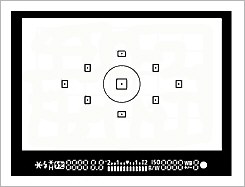

Canon EOS Digital Rebel XSi (EOS 450D) Review
Operating Speed
The Digital Rebel XSi operation is quite responsive, in fact the standards of most small digicams it's blazingly fast! The LCD display comes up in under a second after the camera is turend on, but if you're really in a hurry to shoot you don't have to wait for the LCD display. You can take a shot about 1/4s after you move the power switch to the "ON" position.
In continuous shooting mode, the Canon Rebel XSi can operate at 3.5 frames per sec (fps) for about 55 frames when shooting JPEGs before the buffer fills and the rate drops a little. The buffer is smaller when shooting in RAW mode where you can get about 6 frames at 3.5 fps before the rate drops to around 1 frame every 1.4 seconds (0.7fps). If you choose to shoot images stored as RAW+JPEG, the buffer holds only 4 shots before the frame rate drops. For the vast majority of photographers using the Canon Digital Rebel XSi, the buffer size and frame rate will meet all their needs.
Controls

The Rebel XSi uses a control layout familiar to most Canon EOS users, especially owners of previous DIgital Rebel models. The 3" rear LCD screen displays operating parameters and the various software menus, as well as being used to review images. As is standard in the Digital Rebel line, there is no top mounted LCD screen as there is on the EOS 40D, 50D and other mid and high end EOS bodies. Most of the time this won't be a big deal. The information on the rear color LCD is more readable than that of the top navigated LCDs, though there are some situations in which a top mounted LCD can be more convenient. The firmware menus are navigated via the 4-way controller (allowing navigation up, down, left and right through the menus). There's a center "set" button which is also used to enable Live View modes. In Live View, focusing is enabled by pressing the "*" button. When not being used for navigation, the 4-way buttons are used to select capturing mode, metering mode, AF mode, and picture style.
 The shooting mode is controlled via the main dial on top of the camera. The basic modes include pre-programmed settings optimized for Portrait, Landscape, Close-up, Sports and Night Portrait shots, as well as a Full Auto ("green square") and Flash Off modes. In the creative zone, Intelligent program, shutter-priority AE, aperture-priority AE, depth-of-field AE and manual exposure modes are available. The ON/OFF switch for the camera is on the top deck, around the control dial and there is a dedicated button for setting the ISO speed in the creative modes. The current ISO setting is always displayed in the viewfinder. There is a diopter control wheel just to the left of the viewfinder which controls the focus of the viewfinder screen to compensate for the user's vision.
The shooting mode is controlled via the main dial on top of the camera. The basic modes include pre-programmed settings optimized for Portrait, Landscape, Close-up, Sports and Night Portrait shots, as well as a Full Auto ("green square") and Flash Off modes. In the creative zone, Intelligent program, shutter-priority AE, aperture-priority AE, depth-of-field AE and manual exposure modes are available. The ON/OFF switch for the camera is on the top deck, around the control dial and there is a dedicated button for setting the ISO speed in the creative modes. The current ISO setting is always displayed in the viewfinder. There is a diopter control wheel just to the left of the viewfinder which controls the focus of the viewfinder screen to compensate for the user's vision.
The layout of the firmware menus is similar to that of the Digital Rebel XTi and the EOS 40D. Like the 40D (and 50D) there's a customizable menu screen on which you can place functions you use most so they can be accessed quicky, with a minimum amount of button pushing and wheel turning. For example I put Memory Card Format, Custom WB, Image Quality Selection, Mirror Lockup, Highlight Tone Priority, and High ISO Noise Reduction on the custom menu screen.
Focusing
 The EOS Rebel XSi uses a 9-point wide area AF sensor with the points set in a diamond
pattern, similar to that of the EOS 40D and 50D. The focus point can be manually
selected, or the camera can decide which AF point(s) to use. There are 4 focus modes:
One-Shot AF, AI Focus AF, AI Servo AF, and Manual. The Rebel XSi has a
cross-type (dual axis) AF sensor at the center that's effective with all EF and EF-S
lenses and which provides enhanced precision with lenses having maximum apertures of f/2.8
or faster. The center cross-type AF sensor reads a wider variety of subject matter than
conventional single-axis AF sensors and thus increases the new Rebel XTi's ability to
autofocus quickly and accurately. The outer 8 AF zones use linear (single axis) sensors.
The EOS Rebel XSi uses a 9-point wide area AF sensor with the points set in a diamond
pattern, similar to that of the EOS 40D and 50D. The focus point can be manually
selected, or the camera can decide which AF point(s) to use. There are 4 focus modes:
One-Shot AF, AI Focus AF, AI Servo AF, and Manual. The Rebel XSi has a
cross-type (dual axis) AF sensor at the center that's effective with all EF and EF-S
lenses and which provides enhanced precision with lenses having maximum apertures of f/2.8
or faster. The center cross-type AF sensor reads a wider variety of subject matter than
conventional single-axis AF sensors and thus increases the new Rebel XTi's ability to
autofocus quickly and accurately. The outer 8 AF zones use linear (single axis) sensors.
Live View allows you to use the LCD screen as a viewfinder and directly displays what is being seen by the lens. In Live view there are two focus modes. One is the same as that used on the EOS 40D, where the reflex mirror flips down briefly and the normal AF sensors are used to achieve focus. This is termed "quick mode." The second focus mode (alao available on the EOS 50D but notthe EOS 40D) is "live mode" and uses a contrast-based AF system. The live image is used and focus is determined by looking for maximum contrast. It has the advantage that the LiveView is not interrupted, but it's significantly slower (focus may take a few seconds) and it may not be quite as accurate in all situations as quick mode.
When comparing the AF performance of the XSi and XTi I found them to be quite similar much of the time. However, there were some situations in very low light where the XSi could get an autofocus lock, while with the same lens under the same lighting, the XTi failed. This is consistent with a statement found in the press release for the XSi in which Canon states, "The EOS Rebel XSi Digital SLR utilizes a precise nine-point Autofocus (AF) system featuring a newly developed AF sensor that improves the camera's subject detection capabilities compared to earlier models."
NEXT: ISO Settings and Image Noise
